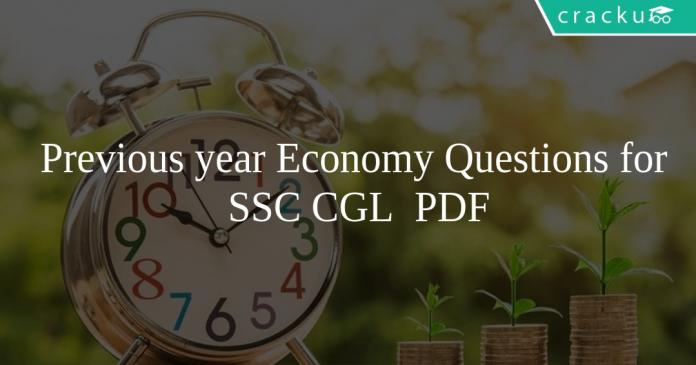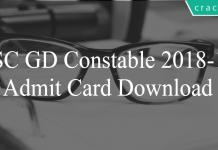Previous year Economy Questions for SSC CGL PDF
Download SSC CGL Economy Questions with answers PDF based on previous papers very useful for SSC CGL exams. Very Important Economy Questions for SSC exams
Download Previous year Economy Questions for SSC CGL PDF
Get 200 SSC mocks for just Rs. 249. Enroll here
Take a free mock test for SSC CGL
Download SSC CGL Previous Papers PDF
More SSC CGL Important Questions and Answers PDF
Question 1: Monopoly means
a) Single Buyer
b) Many Sellers
c) Single Seller
d) Many Buyers
Question 2: Which of the following economic concept is categorized on the basis of Current Account or Capital Account or both ?
a) Balance of payment
b) Value of the foodgrain stock of a country
c) Gross National Product (GNP)
d) Gross National Income (GNI)
e) Total collection of Direct Taxes in a year
Question 3: Which of the following statements about the Growth of Indian Economy in 2009-10 or the part of it, is correct ?
a) Economy grew by 5.8 percent during the period of January-March 2009.
b) India’s growth estimates prepared by the Reserve Bank of India (RBI) say that the growth would be in the band of 8:5 to 10.0 percent during the year 2009-10.
c) The most promising growth of about 6 to 7.5% would be in the agriculture sector which contribute around 60-70 percent in the total GDP of India.
d) Service sector which is a stronghold of the economy is also likely to grow at the rate of 13% during the year.
e) All statements are correct.
Question 4: After the latest global slowdown and financial crisis, a debate is going on, on “Dollar Hegemony”. ‘What does it really mean ? In simple terms
(A)it is the trade practice prevalent all over the world in which USA provides dollars and the rest of the world manufactures the commodities which dollars can purchase.
(B) it is the situation in which all the nations are forcefully required to evaluate their local currencies against the value of the dollars. Hence countries are forced to keep as many dollars as they can to operate safely in global markets.
(C) now economists all over the world are trying to nd out a solution to come out of this dollar trap as this hegemony prevents exporting nations from spending domestically the dollars they have earned from USA.
a) Only A
b) Only B
c) Only C
d) Only A & C
e) All A, B & C
Question 5: As we all know managing inflation has been a very important aspect of the economy in India. Which of the following is/are true about the inflation and its effect on economy ?
(A) Lack of inflation (deflation) is not necessarily a thing which is always good.
(B) Inflation is an Increase In the general level of prices for goods and services.
(C) When inflation goes up, the purchasing power of the money also goes up.
a) Only A
b) Only B
c) Only A & B
d) Only A & C
e) None of these
Question 6: Which of the following is the correct definition of the term National Income ?
(A) National Income means the total amount of money Govt. earns only through direct tax collections. every year.
(B)It is the total value of all sorts of stocks held by a country at a particular point of time.
(C) This is the measure of the volume of commodities and services turned out during a given period counted without duplication.
a) Only A
b) Only B
c) Only C
d) All A, B & C
e) None of these
SSC CGL Previous Papers Download PDF
Question 7: One of the key factors that provide impetus 10 strong growth is Interest Rates. How do interest rates contribute to the growth of economy particularly when these are lowered down ?
(A) It gives corporations the opportunity to prepay high cost debts and replace them with fresh funds raised at lower rates.
(B) Banks use this opportunity to maximize pro ts on their treasury operations and these excess pro ts are used to clean their Balance Sheets by making higher provisions for NPAs or sticky loans.
(C)The Govt. also gets benefited as it can borrow funds from open market at low interest rates and bridge its fiscal deficit.
a) Only A
b) Only B
c) Only C
d) All A, B, & C
e) None of these
Question 8: As we all know Govt. of India pays special emphasis on management of Fiscal Deficit. What is Fiscal Deficit ?
a) The gap between projected or estimated GDP and actual GDP
b) The gap between the total number and value of the currency notes issued by the RBI uptill now over the number and value of those which are of actual circulation
c) The gap between the actual borrowings of the Govt. of India and the expected expenditure for which provision is made in the budget
d) Excess of Govt’s disbursement comprising current and capital expenditures over its current receipts (Tax/non tax receipts)
e) None of these
Question 9: An argument amongst the economists all over the world is going on, on the issue of imposing special taxes on goods and services whose prices do not reflect the true social cost of their consumption, for example, tax on polluting environment. Which of the following are the other examples of such taxes ?
(A) Duties on cigarettes
(B) Duties on alcohol
(C) Tax on gambling and lotteries
(D) Airport Tax
a) Only A
b) Only A & B
c) Only A, B & C
d) All A, B, C & D
e) None of these
Question 10: Which of the following is/are correct statements as per the “World Bank’s Report on Global Economy” ?
(A) The report says that India’ growth rate will swing back to 8 percent in 2010 and move to 8.5 percent in 2011
(B) Global growth will be even worse than what we saw earlier. There may be 2.9 percent contraction in 2009
(C) Report says that Brazil and China will emerge as two fastest developing economies of the world in 2011 and 2012. India may be lagging behind as its infrastructure development is very slow and inappropriate.
a) Only A
b) Only B
c) Only A & B
d) All A, B & C
e) None of these
Question 11: As we all know India’s one of the major Imports is oil and petroleum. Out of the total consumption of the oil and petroleum, how much is consumed by the transport sector ? About
a) 20%
b) 40%
c) 30%
d) 50%
e) 60%
Question 12: Specially Developed Economic Zones (SEZs) in India where some of the economic laws and restrictions of the land are relaxed with the purpose of giving incentives to investors are commonly known as
a) Preferential zones
b) Economic Corridors
c) Industrial parks
d) Special Economic Zones
e) None of these
Question 13: Stock market indexes traditionally served as a benchmark to measure the performance of which of the following types of. portfolios of the investors/promoters ?
a) Equity portfolio
b) Tax saving instruments
c) Mutual Funds
d) Investments in Govt. Securities
e) All of these
Question 14: Which of the following is the name of the organisation, created to provide full employment and self – reliance to the women folk in India ?
a) OECD
b) ROSCA
c) SVP
d) USO
e) SEWA
Question 15: Many a times we come across a term ‘DDT’ in the nancial/ economic transactions. What is the full form of the same ?
a) Direct Distribution Treaty
b) Dividend Distribution Tax
c) Delhi Denmark Treaty
d) Direct Distribution Terminals
e) None of these
18000+ Questions – Free SSC Study Material
Answers & Solutions:
1) Answer (C)
2) Answer (A)
3) Answer (A)
4) Answer (B)
5) Answer (C)
6) Answer (C)
7) Answer (A)
8) Answer (D)
9) Answer (B)
10) Answer (B)
11) Answer (C)
12) Answer (D)
13) Answer (A)
14) Answer (E)
15) Answer (B)
We hope this Economy Questions for SSC CGL Exam preparation is so helpful to you.





